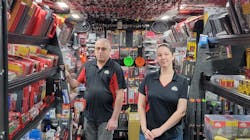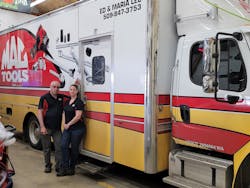Content brought to you by Professional Distributor. To subscribe, click here.
Did you know that 87 percent of shops own a scan tool? Or how about that even if a shop owns one scan tool or multiple scan tools, 24 percent of technicians have also purchased their own? These stats are straight out of this year’s Aftermarket Profile—a comprehensive guide of the automotive aftermarket that provides insights from over 300 PTEN readers on tool and equipment purchases they’ve made recently or plan to make soon—and they prove just how important having a scan tool is to shops and individual technicians alike.
Ed and Maria Lee are a Mac Tools team who understand the significance of getting the correct scan tool in the hands of their customers. Traveling through their route in Spokane, Washington, the duo makes stops at dealerships, independent shops, private shops, body shops, and a few farms. They have a little bit of everything along their route, and between their lineup of Mac scan tools, which are branded Bosch products, and their offering of the full Launch Tech lineup, the couple has a scan tool fit for each and every technician they visit.
New features and functions
The technology in vehicles is in a constant state of advancement, so it makes sense that the tools and equipment used to fix them are also advancing. Unfortunately, a scan tool’s updates can be a bit trickier to keep track of than a screwdriver with a new ergonomic handle. However, one way Ed and Maria have found that helps them to stay on top of new features and updates is by staying in touch with representatives from their scan tool’s manufacturers.
“Bosch does a really good job of keeping us well informed of what’s in every new update, and our updates come out at a minimum once a quarter, but it’s probably more like six or seven times a year,” Maria says. “And so, we review those updates pretty thoroughly for what’s new coming to the scan tool at that time.”
Though you may only stock one or two brands of different scan tools, having an understanding of what’s new with some other brands could be beneficial. Perhaps there’s a brand that has features better suited for your customers. Or maybe having this knowledge will better enable you to compare and contrast features between what you stock from a competitor.
Here are a few updates from three scan tool manufacturers on what’s new in their product lineups.
Autel
Autel Technical Trainer, John Forro covers a handful of Autel’s largest changes he believes mobile tool dealers should be aware of.
“Our top-tier tools support the newest protocols found on today’s vehicles such as Can FD and DoIP,” Forro notes.
He explains that “protocol” just means the language and speed that the modules talk. The Can FD protocol was started in 2019 on select Ford products, whereas the DoIP or diagnostics over the internet protocol is commonly used by European manufacturers like BMW.
Autel’s lineup of scan tools also supports an exclusive EV diagnostic box that allows technicians to perform diagnostics on the battery management system, as well as HVAC compressors. This update enables technicians to run these tests on or off the vehicle.
“This new technology allows one to see information and perform bidirectional tests that we could never do before by simply seeing the information shared along the data bus communications lines found within the typical OBD-II connector,” Forro says.
Additionally, by being able to run these tests, technicians will have the ability to routinely perform calibrations on high-voltage batteries which could help in prolonging battery life.
Bosch
“One function mobile tool dealers should be aware of is internet connectivity and how it can extend the life of scan tools – ultimately saving shop owners and technicians money in the long run,” explains Scott McKinney, senior product manager for Bosch Automotive Aftermarket. “Internet connectivity allows tool and equipment manufacturers to share updates with technicians digitally and can store information on specific vehicles via a cloud connection.”
By utilizing a cloud connection, shops won’t need to store any vehicle data, which could lead to improved performance and efficiency of the scan tool, McKinney notes.
Just as Maria notes above, McKinney agrees that paying attention to software renewals and updates is crucial. Knowing the latest added coverage of the scan tools you stock could be the difference between making or losing a sale. Your customers never know what vehicle might end up in their bay, but you can help reassure them with a scan tool that provides them with access to the most up-to-date information on their customers’ vehicles.
Launch Tech USA
The X431FIX by Motor is one of Launch Tech’s newest feature upgrades for their X-431 scan tool lineup. The repair information database can be opened on the scan tool and offers users access to repair diagrams, electrical schematics, images, and more.
“The goal of implementing this feature is for accessibility and time productivity,” says Haresh Gobin, product development manager for Launch Tech USA. “Now the technician does not need to leave the vehicle while formulating their diagnostic work plan and identifying issues. They have access to all the repair and OEM specifications in the X431FIX on their X-431 scan tool.”
A few other recent updates for the X-431 lineup include ADAS calibration software and target upgrades, immobilizer diagnostic functions, and a streamlined interface for oscilloscope waveform analysis, Gobin lists.
Any questions?
When selling a tool as complex as a scan tool you’re bound to get some questions. Most customers aren’t going to know exactly what they want and/or need for their shop. The best place to start is by breaking down what vehicles they have coming into their bays.
Vehicle workflow analytics
Gobin recommends taking a look at the shop’s vehicle workflow analytics—what type of services and repairs are they performing? What is the skill level of their technicians? Do they perform any specialty work? Are they working on domestic, European, or Asian vehicles or is it a bit of each?
He also advises thinking about more advanced diagnostics such as module replacement, reflashing/reprogramming, and ADAS calibrations. It’s important to take into consideration whether these repairs are taking place in-house or are being outsourced.
Product support and training
After these questions are answered you’ll want to discuss the type of support the scan tool’s manufacturer has to offer. What happens if the scan tool breaks or a technician is uncertain about how to perform a specific scan?
Ed and Maria ran into a situation where a lack of support cost someone a customer. When they went to visit a shop in Airway Heights, they came across a technician who was having trouble contacting a competitor’s support team for their scan tool. The couple asked the technician what they were trying to do, and then Ed brought in one of their scan tools and showed the technician how their device could solve the problem.
“In answering their questions and putting them in contact with our support team, they bought the tool on the spot,” Ed says.
In addition to support, customers should also think about training.
“While using a scan tool doesn’t require any specific certification,” McKinney notes, “there’s great value in exploring training sessions to keep skills sharp and learn how to tackle new and unique problems.”
Forro also mentions that Autel, like many scan tool manufacturers, puts together training videos for their products that can be found on social media platforms like YouTube.
Additional sales
A scan tool can only do so much for a technician on its own. Recommending some accessories to your customers may help them get a better, more in-depth use out of their device.
“The primary thing to remember when viewing scan tool data is that it is interpreted data,” Forro says. “This means that there is a margin for error in diagnostics. For this reason, a technician will need to accompany their scan tool with other equipment such as a lab scope, a multimeter, and a signal generator.”
McKinney also suggests wireless borescopes for more access in tight spots, battery testers, and noise, vibration, harshness (NVH) analyzers for optimizing noise in a vehicle as other optional accessories.
Selling Tips
Scan tools can be complicated, but selling them doesn’t have to be—with some basic knowledge, a good support team behind you, and a few sales tips for added guidance, you should be on track for making the sale.
1. Utilize your support team
Maria is a firm believer that as long as you have the right support behind you in your diagnostic team, you don’t have to be able to answer every question your customer asks you.
“I can answer questions on how my scan tool works and where to go because I played with the scan tool and used it to do certain features, but I can't tell you about a specific question for that make and model of a car,” Maria explains. “That's where our diagnostic team and support team come into play. I can show you a scan tool without a problem, but I'm not worried about being able to answer all the technical questions for the car.”
2. Demo mode
Many scan tool manufacturers now include a “demo mode” on their devices so technicians can get a feel for how the scan tool works before making a purchase.
Gobin explains that on Launch Tech’s X-431 platform, the demo features “simulates the OBD connection to a vehicle and allows the potential customer or user of the scan tool to view the interface [and] ease of navigation while allowing the user to explore the features of the diagnostic software platform.”
Users can explore features like vehicle coverage and check out the tool’s ability to diagnose and repair a variety of vehicles.
3. Address your customers’ needs
When speaking to a customer about buying a scan tool, Ed likes to start out by asking them where they’re at in their career and where they’d like to go. He wants to get a feel for the customer and whether they’re going to be staying in the auto industry or are just making a pit stop.
“From there I talk to the technicians about what they’re doing day-in, day-out and asking them if they are at a good point in their career or if they're wanting to further their knowledge,” Ed says. “That kind of directs me to which scan to put them in to make them happiest.”
4. Have the tools available
Forro recommends having an inventory of the tools you’re selling.
“No one likes to wait for shipping,” he says.
Having that inventory available also enables you to have a few loaner or demo tools at the ready, so customers can try out the device for a while before making their final decision on purchasing.
5. Play to your strengths
Ed and Maria both run the truck together full-time, and they use this to their advantage.
“You don’t come across that very often in the tool industry,” Maria notes. “Having both of us present on the truck allows us to cater to our customers’ needs. If somebody is asking about a scan tool, one of us can provide that customer with one-on-one time while the other one deals with the rest of the shop. If there are multiple people with questions, [we can] field those questions a lot easier between the two of us.”
The duo also plays off of each other’s strengths.
“Ed has that knowledge of the technical side of using the scan tool, whereas I have the knowledge of setup and functionality of the scan tool,” Maria explains, “and between the two of us, it works to our benefit pretty much every time we start talking seriously to a customer about a scan tool.”
Ed and Maria’s top 5 selling scan tools
- Mac Tools ET9200 Elite
- Launch Tech X-431 Torque 5
- Launch Tech X-431 Throttle III
- Mac Tools ET9200 Advanced
- Mac Tools ET8250-HD
About the Author
Emily Markham
Editor | PTEN and Professional Distributor
Emily Markham is the editor of Professional Tool & Equipment News (PTEN) and Professional Distributor magazines. She has been writing about the automotive aftermarket since 2019, after graduating from UW-La Crosse with a bachelor's degree in English. During her first three years with EndeavorB2B's Vehicle Service & Repair Group, Markham also wrote for Fleet Maintenance magazine.
Don't miss Markham's next article. Sign up for PTEN or Professional Distributor's weekly newsletter.






